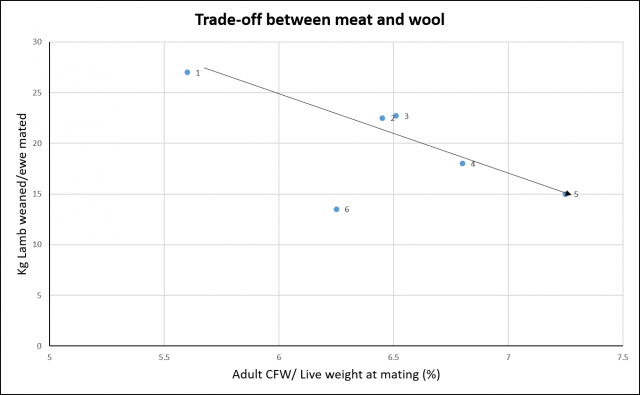Genetic trade-offs between lamb and wool production in Merino breeding programs
Johan Greeff
Department of Primary Industry and Regional Development, 3 Baron Hay Court, South Perth, Western Australia
Author correspondence: johan.greeff@agric.wa.gov.au
Abstract
Merino breeding programs generally focus strongly on the wool production traits. However, selecting only for increased wool production can result in undesirable responses because of the negative relationships that exist between wool production and the reproduction traits. Thus breeding programs should be more balanced and should aim to improve both meat and wool production traits simultaneously.
Introduction
The Merino has mainly been selected for wool production for a very long time. Research carried out at Katanning research station showed that there was genetically a negative relationship between fleece weight and ultrasound fat depth in hogget Merinos (Greeff et al. 2006; Adams et al. 2007). This implies that if selection is aimed at improving wool production, then the Merino will get leaner over time.
During the last decade genetic improvement of the Merino shifted towards a more dual purpose type of sheep in Western Australia. Other research has shown that there was a negative genetic relationship between number of lambs weaned and fleece weight that varied from minus 0.10 to minus 0.49 (Safara and Fogarty, 2003). Thus we postulated that if a negative relationship in hogget ewes also hold in mature ewes, then the heavier wool producing ewes would be leaner, having less reserves and more likely to wean less weight of lambs than ewes that produce less wool.
We investigated these relationships in the Katanning base flocks. The data were collected on mature ewes from six different Merino strains from 1986 to 1993. The flock consisted of approximately 1800 mature ewes which were run and managed in four separate management groups.
The ewes were extensively measured for wool, growth and the reproduction traits over their lifetime. In this analysis we used adult ewe live weight (ALWT) at mating and adult clean fleece weight (ACFW). Clean fleece weight was corrected for litter size and for sex of the lamb. We expressed the wool production potential as the percentage of wool produced per kilogram of live weight (ACFW/ALWT), and this was plotted against wool production potential for six different Merino strains.
Results
The figure below shows the kilograms of lamb weaned per ewe mated plotted against wool production potential (ACFW/ALWT) for the six different Merino strains.
It is clear that apart for strain 6, which was a superfine wool strain, there was a remarkable negative linear relationship between meat production and wool production potential for strain 1 to 5. This indicates that strains with high wool production potential will tend to produce less lambs than strains with a lower wool production potential. The fine wool strain is clearly an outlier and according to the trend line it should have had a higher reproduction rate. However, closer examination of the data also showed that this strain had a lower fertility, litter size, survival rate and growth rate up to weaning compared to the other groups. As fibre diameter is positively correlated to reproduction rate, this implies that selecting for reduced fibre diameter resulted in a lower reproduction rate.
These results support the research by Herselman et al. (1998) who concluded that fitness may be compromised in animals with a high potential for fibre production. However, it is important to realise that these results do not mean that selecting for increased fleece weight and finer wool should or will have an inevitable negative impact on reproduction rate. Nevertheless, although this negative relationship exists, the actual genetic relationships between these traits are not very strong and the relationships can be bent by using breeding values. Breeding values for reproduction and fat reserve traits were not available at the time when these sheep in this experiment were selected for increased wool production. As reproduction rate and its components are heritable and usually have a high variation, they can be improved by selecting directly for number of lambs weaned in ewes or using scrotal circumference in rams as an indirect trait. Sheep Genetics has an extensive database on breeding values for a wide range of traits. These breeding values can be used to improve both fleece weight and the reproduction traits simultaneously. Breeders are therefore strongly encouraged to use these breeding values to ensure that reproduction rates will not deteriorate while selecting for increased production.

Conclusion
Breeding programs should focus on all the economically important production traits and not focus only on a few specific traits. This implies that the breeding goals of the Merino should be broadened to increase both meat and wool production. Breeding values of a wide range of economically important traits are available from Sheep Genetics to assist breeders to identify genetically superior sheep without sacrificing fitness or reproduction while selecting for increased meat and wool production.
References
Adams NR, Briegel JR and Greeff JC (2007). Responses of wool growth rate and body reserves to nutrition in Merino ewes: a potential biological link between production and fitness. Aust. J. Agric. Res. 58, 913-920.
Greeff JC, Cox G, Butler L, Dowling M (2005). Genetic relationships between carcass quality and wool production traits in Australian Merino rams. Proceedings of the Association for the Advancement of Animal Breeding and Genetics 16, 12–15.
Herselman MJ, Olivier JJ and Snyman MA (1998). Studies on small ruminant breeds with inherent differences in fibre production and ewe productivity. 1. Relationship between ewe productivity and wool production potential. S. Afr. J. Anim. Sci. 28, 1-8.
Safara A, and Fogarty N.M. (2003). Genetic parameters for sheep production traits. Technical Bulletin 49 NSW Agriculture.
